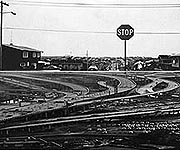|
July 10 , 2000 The
End Is Near Temp
Slave Revolt Locked
Down Editorial Forgotten
America Appall-O-Meter Bully
Culprit Three's
Company Don't
Drink the Water Eight
Is Enough Pass
the Petition Profile Botched
Burbs Harrington's
Way Slaughterhouse
Live Shakespeare
Inc. Post-Feminist
Smackdown! |
By Sandy Zipp
Suburban
Nation: The Rise of
Sprawl and the Decline of the
American
Dream
By Andres Duany, Elizabeth
Plater-Zyberk and Jeff Speck
North
Point Press
256 pages, $30
Picture Windows:
How the
Suburbs Happened
By Rosalyn Baxandall and
Elizabeth Ewen
Basic Books
298 pages, $27.50
 |
What has happened to the American suburb? Once the utopian locale where city and country met, where nature and culture were brought into polite conversation, the suburb is no longer a pastoral borderland or even the mundane stage - set for middle America's sit-com fantasies.
Only a few generations since the heady days of postwar triumphalism, the friendly suburb has mutated into sinister sprawl. As Andres Duany, Elizabeth Plater-Zyberk and Jeff Speck report in their recent manifesto Suburban Nation, those cheerful ranch houses arrayed in spotless, assembly-line rows on idyllic virgin land have mutated into swirling viruses of McMansions, garage-fronted stucco shacks and cul-de-sacs pushing their way relentlessly into imperiled wetlands and forest belts.
These much-heralded - and much-derided - pioneers of "new urbanist" architecture are confident that they have a popular antidote to sprawl. They are no doubt on to something, having made very successful careers out of stumping for a return to the "traditional neighborhood." They claim this buried, longed-for tradition was the dominant form of Western habitation before the mid-20th century, originally evolving, they write, "organically as a response to human needs" in the form of "mixed-use, pedestrian-friendly communities of varied population, either standing free as villages or grouped into towns and cities."
But reading Rosalyn Baxandall and Elizabeth Ewen's new history, Picture Windows: How the Suburbs Happened, next to the architects' impassioned plea is instructive. In the hands of these historians, the suburb becomes not an anesthetized state of mind but a flawed and tragic chapter in the noble story of "America's attempts to provide housing to all of its citizens." If the new urbanists find suburbs wanting for "a physical framework conducive to public discourse," Baxandall and Ewen counter with the suggestion that postwar suburbs never truly provided an easy escape from the cacophony of civic life. Using Long Island as an historical laboratory, they trace its development from farmland to leisure-class retreat to mass-marketed worker's paradise, stressing throughout the struggles over race and class that transformed the landscape of Walt Whitman's Paumanok into Levittown.
![]()
|
In These Times ©
2000 |
